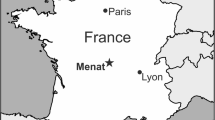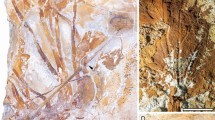Summary and Conclusions
A specimen from the late Devonian Katsberg beds of Delaware County, New York, comprising a pyritized axis determined asCallixylon and leaves determined asArchaeopteris, is described and illustrated. The leaves are probablyA. macilenta Lesquereux and the axisC. zalesskyi Arnold, but because of doubt of the specific identity of the leaves a nomenclature transfer is delayed.
Archaeopteris, the valid name for the plant represented by the organ generaArchaeopteris andCallixylon, is included withPitys andArchaeopitys in the Pityales which, together with the orders Aneurophytales and Protopityales, is assigned to the newly recognized class Progymnospermopsida. This class includes woody, pteridophytic plants bearing (where known) large compound leaves or leaf-like branch systems. In numerous characters of both external morphology and internal structure these plants are remarkably similar to two groups of gymnosperms, the Pteridospermales and Cordaitales, which are, respectively, the most primitive groups of the cycadophyte and coniferophyte lines of gymnosperm evolution. Because the Progymnospermopsida are pteridophytic they can-not be logically classified with the ovule-bearing gymnosperms, but it is very likely that they comprise the ancestral complex from which the major groups of gymnosperms evolved. Certain primitive features, especially of the Aneurophytales, suggest that the Progymnospermopsida are descended directly from some psilophyte-like ancestors.
The existence of such a group of pteridophytic plants, of possible psilophytic origin, obviously not ferns, showing unmistakeable gymnosperm characters, and which preceded any known gymnosperms in time, eliminates the necessity to consider any group of ferns, known or unknown, as ancestors of the gymnosperms. This supports the separation by Bold (1956) of the Filicineae and Gymnospermae, and in part his abandonment of Pteropsida. On the other hand it suggests that the major groups of gymnosperms (possibly excluding the Gnetales) have a common ancestry, are consequently genetically related, and should, therefore, be retained in a single inclusive taxon.
Similar content being viewed by others
Literature Cited
Andrews, H. N. 1940. On the stelar anatomy of pteridosperms, with particular reference to the secondary wood. Ann. Missouri Bot. Gard.27: 51–119.
Arnold, C. A. 1930. The genusCallixylon from the Upper Devonian of central and western New York. Papers Mich. Acad.11: 1–50.
—. 1931. OnCallixylon newberryi (Dawson) Elkins et Wieland. Contr. Mus. Paleont. Univ. Mich.3: 207–232.
—. 1936a. Observations on fossil plants from the Devonian of eastern North America. I. Plant remains from Scaumenac Bay, Quebec. Contr. Mus. Paleont. Univ. Mich.5: 37–48.
—. 1936b. Observations on fossil plants from the Devonian of eastern North America. II.Archaeopteris macilenta andA. sphenophyllifolia of Lesquereux. Contr. Mus. Paleont. Univ. Mich.5: 49–56.
—. 1939. Observations on fossil plants from the Devonian of eastern North America. IV. Plant remains from the Catskill Delta deposits of northern Pennsylvania and southern New York. Contr. Mus. Paleont. Univ. Mich.5: 271–314.
—. 1940. Structure and relationships of some Middle Devonian plants from western New York. Am. Jour. Bot.27: 57–63.
—. 1947. An introduction to paleobotany. McGraw-Hill Book Co., New York.
—. 1948. Classification of gymnosperms from the viewpoint of paleobotany. Bot. Gaz.110: 1–12.
—. 1953. Origin and relationships of the cycads. Phytomorphology3: 51–65.
Beck, C. B. 1953. A new root species of Callixylon. Am. Jour. Bot.40: 226–233.
—. 1955. A technique for obtaining polished surfaces of sections of pyritized plant fossils. Bull. Torrey Club82: 286–291.
—. 1957.T etraxylopteris schmidtii gen. et sp. nov., a probable pteridosperm precursor from the Devonian of New York Am. Jour. Bot.44: 350–367.
—. 1960. Connection betweenArchaeopteris andCallixylon. Science131: 1524–1525.
Berry, E. W. 1917. The classification of vascular plants. Proc. Nat. Acad. Sci.3: 330–333.
Bold, H. C. 1956. Some aspects of the classification of the plant kingdom. Bull. Assoc. Southeast. Biol.3: 1–5.
Coulter, J. M. &Chamberlain, E. J. 1910. Morphology of gymnosperms. Univ. of Chicago Press, Chicago.
Dawson, J. W. 1871. The fossil plants of the Devonian and Upper Silurian formation of Canada. Geol. Surv. Canada, Montreal.
Delevoryas, T. &Morgan, J. 1954. A new pteridosporm from Upper Pennsylvanian deposits of North America. Palaeontographica96B: 12–13.
Gordon, W. T. 1935. The genusPitys, Witham, emend. Trans. Roy. Soc. Edinburgh58: 279–311.
Hirmer, M. 1927. Handbuch der Paläobotanik. R. Oldenbourg, München.
Hoeg, O. A. 1942. The Downtonian and Devonian flora of Spitsbergen. Norges Svalbardog Ishavs-undersøkelser83: 1–228.
Johnson, T. 1911. IsArchaeopteris a pteridosperm? Sci. Proc. Roy. Dublin Soc. N. S.13: 114–136.
Joy, K. W., Willis, A. J. &Lacey, W. S. 1956. A rapid cellulose peel technique in palaeobotany. Ann. Bot.20: 635–637.
Kidston, B. 1906. On the microsporangia of the Pteridospermeae, with remarks on their relationship to existing groups. Phil. Trans. Roy. Soc. London198B: 413–445
—, &Lang, W. H. 1923. OnPalaeopitys Milleri M’Nab. Trans. Roy. Soc. Edinburgh53: 409–417.
Kräusel, R. &Weyland, H. 1935. Pflanzenreste aus dem Devon. IX. Ein Stamm vonEospermatopteris-Bau aus dem Mitteldevon des Kirberges, Elberfeld. Senckenbergiana17: 9–20.
—. 1941. Pflanzenreste aus dem Devon von Nord-Amerika. II. Die Oberdevonischen Floren von Elkins, West-Virginien, und Perry, Maine, mit Berücksichtigung einiger Stücke von der Chaleur-Bai, Canada. Palaeontographica86B: 3–78.
Leclercq, S. 1951. Étude morphologique et anatomique d’une fougère du Dévonien Supérieur. LeRhacophyton zygopteroides nov. sp. Ann. Soc. Géol. Belg.9: 1–62.
Lesquereux, L. 1884. Description of the coal flora of the Carboniferous formation in Pennsylvania and throughout the United States. Second Geol. Surv. Penn. Vol. III, Report of Progress P. Harrisburg.
Nathorst, A. G. 1902a. Zur Oberdevonischen Flora der Bären-Insel. J. Svenska Vetenskaps-Akad. Handl.36 3: 1–60.
—. 1902b. Beiträge zur Kenntnis einiger Mesozoischen Cycadophyten. K. Svenska Vetenskaps-Akad. Handl.36 4: 1–28.
Nemejc, F. 1950. The natural systematic of plants in the light of the present palaeontological documents. Sborník Nár. musea Praze6B 3: 1–83.
—. 1959. Notes on the evolution and taxonomy of the stachyospermic gymnosperms. Preslia31: 251–272.
Read, C. B. 1937. The flora of the New Albany shale. Part 2. The Calamopityeae and their relationships. U. S. Geol. Surv. Prof. Pap.186E: 81–104.
Sahni, B. 1920. On the structure and affinities ofAcmopyle Pancheri, Pilger. Phil. Trans. Roy. Soc. London210B: 253–310.
Saporta, G. & Marion, A. F. 1885. L’évolution du règne végétal. Les phanérogames. Vol. 1. Paris.
Scott, D. H. 1923. Studies in fossil botany. Ed. 3, Vol. 2. A. and C. Black, Ltd., London.
—, &Jeffrey, E. C. 1914. On fossil plants, showing structure, from the base of the Waverley shale of Kentucky. Phil. Trans. Roy. Soc. London205B: 315–373.
Takhtajan, A. L. 1953. Phylogenetic principles of the system of higher plants. Bot. Rev.19: 1–45.
Walton, J. 1957. On Protopitys (Göppert): with a description of a fertile specimen“Protopitys scotica” sp. nov. from the Calciferous sandstone series of Dunbartonshire. Trans. Roy. Soc. Edinburgh63: 333–340.
Worsdell, W. C. 1906. The structure and origin of the Cycadaceae. Ann. Bot.20: 129–159.
Zalessky, M. D. 1911. Étude sur l’anatomie duDadoxylon tehihatcheffl Goeppert. Mém. Comité Géol. Russe, N. S.68: 18–29.
Author information
Authors and Affiliations
Rights and permissions
About this article
Cite this article
Beck, C.B. The identity of Archaeopteris and Callixylon. Brittonia 12, 351–368 (1960). https://doi.org/10.2307/2805124
Issue Date:
DOI: https://doi.org/10.2307/2805124




